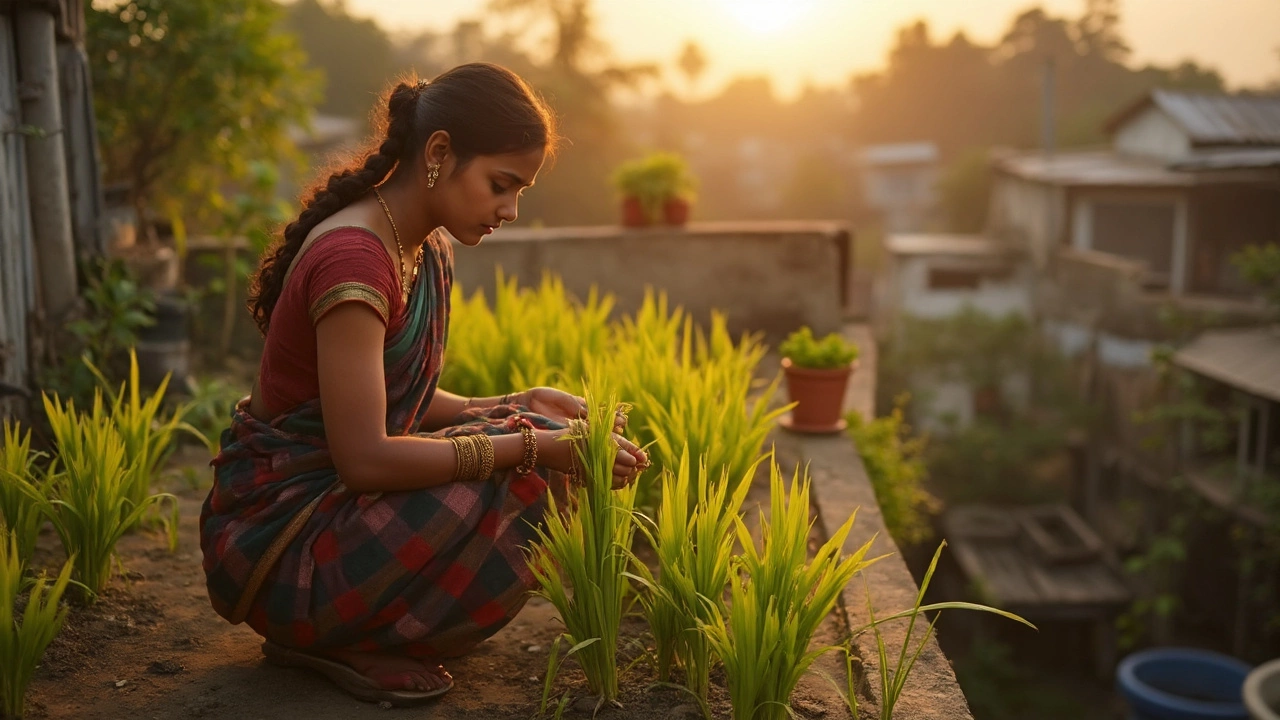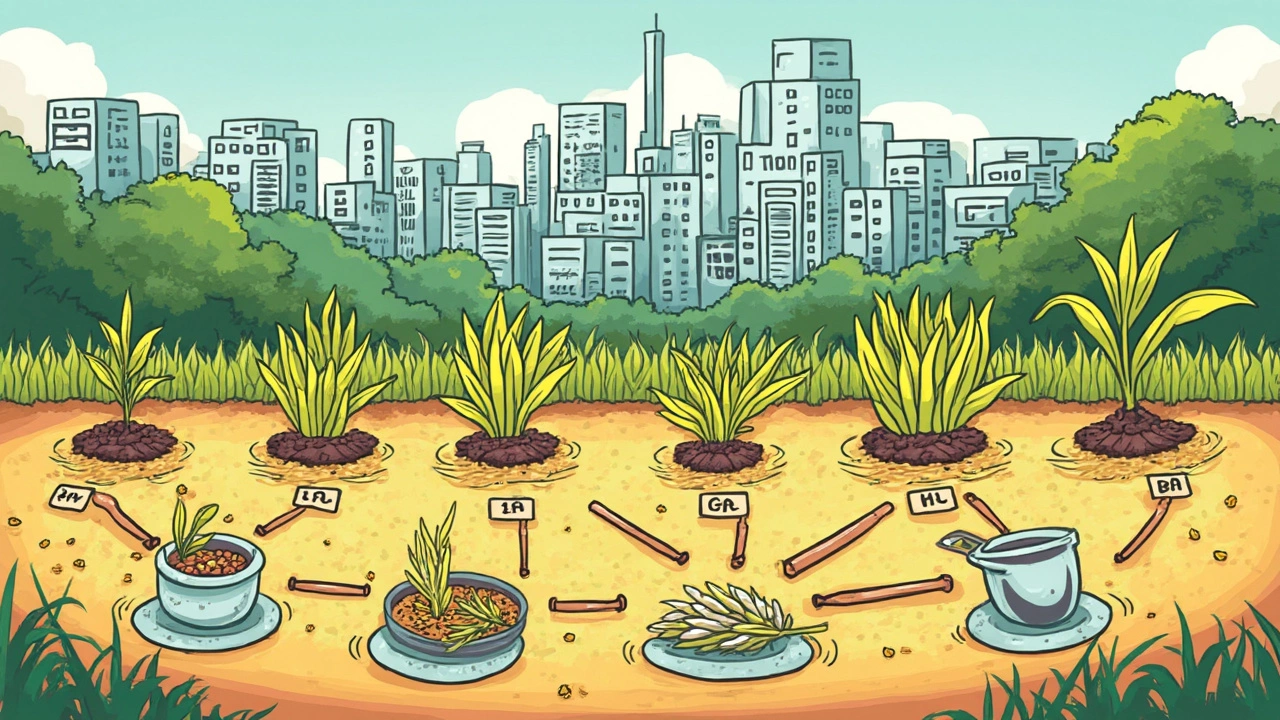Thinking about growing rice at home? It's not as crazy as it sounds. With a bit of space and some water, you can have your own mini rice paddy right in your backyard or even on a balcony. But before you start, there's some ground to cover.
First off, you'll need to figure out how much space you have. Rice is a water-loving plant, so it needs a large container that can hold water or a small plot of land. For those experimenting in small spaces, it's totally possible to start with a few buckets or kiddie pools. Yeah, it sounds a bit like a science project, but it works!
Next, think about time. Growing rice is a few-month commitment. You'll be planting, maintaining, and then harvesting. It's like having a pet that doesn't bark or need walks but does require some attention.
The process itself isn’t rocket science. Starting with the right type of rice seed is crucial. Look for small packets labeled for home gardening, which are often more forgiving for beginners. Then it's about maintaining moisture levels and figuring out when to drain and when to flood. Plus, you'll learn a thing or two about pests along the way.
There are definitely some perks. Home-grown rice tends to be fresher and tastier than store-bought. And there's the satisfaction of cooking a meal with rice you've nurtured yourself. But is it worth the effort, especially when a bag of rice is so cheap at the store? That's the real question. Let's dive a bit deeper to find out.
- Getting Started with Home Rice Cultivation
- Space and Conditions Needed
- Step-by-Step Growing Process
- Potential Benefits and Drawbacks
- Is It Worth the Effort?
Getting Started with Home Rice Cultivation
So, you're thinking about diving into the world of home rice farming? Great choice! It's a rewarding hobby that connects you to your food in a whole new way. Plus, it's a fun conversation starter when you say, 'I grow my own rice.'
Picking the Right Space
First thing's first: location, location, location. Rice needs a spot with lots of sunlight. Ideally, find a place that'll get at least six hours of sun a day. If you're short on backyard space, don't worry. Many people successfully grow rice in containers!
If you're using a container, make sure it's big enough. A standard-sized kiddie pool or even a few five-gallon buckets lined up can do the trick. Remember, rice loves water, so your setup should hold water pretty well.
Getting the Right Supplies
Next up: seeds. Not all rice is created equal. You'll want to grab some seeds that are known to do well in home gardens. Look for rice seeds at specialty garden centers or online stores. Jasmine and brown rice are popular choices for beginners.
Basic Watering Needs
The cool part about growing rice? It loves water—lots of it. Plan to flood your container or plot with at least a few inches of water. This is essential in the early growth stages. Don't worry if the setup looks like a mini swamp; that's exactly what rice needs.
Creating the Right Conditions
Did you know rice has been cultivated by humans for over 8,000 years? No wonder it has such specific growing needs! Rice thrives in warm, humid conditions, so if you live in a cooler climate, consider starting your crop indoors and moving it outside once it's warm enough.
Always make sure your chosen area can accommodate these conditions without becoming a mud pit. A light soil mix helps provide good drainage even when flooded.
Starting your own rice cultivation at home might seem daunting, but following these steps can make the process straightforward. With sunlight, water, and a little TLC, your homegrown rice meal will be something to savor—not just for the taste, but for the journey from seed to plate.
Space and Conditions Needed
Before you start dreaming of home-grown rice on your dinner plate, let's talk about where this would actually happen. The good news is that you don’t need acres of land to grow rice, but there are some key things to keep in mind.
Amount of Space
If you're planning to grow rice at home, you need to consider the size of your available space. For those with a backyard, even a small plot can work. A space that’s roughly 5 feet by 5 feet is enough to test the waters. Don’t have a backyard? No worries. You can use a few large containers—like buckets or kiddie pools—which can easily sit on a balcony or patio.
Environmental Conditions
Rice loves water—like, a lot of it. You’ll need to mimic a mini wetland. Ideally, rice needs full sunlight, so place your containers or plot where they'll get plenty of direct sun.
Temperature and Climate
Rice thrives in warm climates. Aim for a consistent temperature of around 70°F (21°C) or higher. If you live in a cooler climate, consider starting the plants indoors and moving them outside once it warms up.
Soil Requirements
The soil for your rice should be nutrient-rich. You might want to enhance it with some organic compost to give your rice plants all they crave. The soil should be able to hold water effectively, which is key for successful rice cultivation.
Water Management
Mimicking the flooded fields of traditional rice paddies is essential. The soil should be waterlogged during the growing season but also needs good drainage systems like small holes or pipes to prevent stagnant water.
| Factor | Ideal Condition |
|---|---|
| Sunlight | At least 6-8 hours daily |
| Temperature | 70°F (21°C) or higher |
| Soil | Nutrient-rich, well-draining |
| Water | Consistently wet, but not stagnant |
Get these essentials right, and your rice plants are set for success—or at least a good start. Next, let's look at how to kick off the growing process.

Step-by-Step Growing Process
Alright, so you're all set to dive into growing rice at home. Let's break it down into easy steps to keep you on track.
1. Choose the Right Rice Variety
The first step is picking the right seeds. Look for varieties that mention they're suitable for small-scale or home rice cultivation. They tend to handle less-than-perfect conditions better, like Jasmine or Basmati if you like aromatic rice.
2. Prepare Your Container or Plot
Whether you're using a container or a small plot, make sure it's ready to hold some water. If it's a container, drill a few small holes for drainage at the base. For plots, it's about making little mounds to ensure drainage but also water collection.
3. Germinate the Seeds
Before planting, soak the seeds in water for about 24 hours. Then, drain the water and let them sit in a damp cloth or paper towel until they sprout, which takes 2-3 days. This jump-starts their growth.
4. Planting
Once the seeds have sprouted, plant them about an inch deep in the soil. Space them around 6 inches apart because they need room to grow without competing for resources.
5. Water Management
Here's where the home rice farming gets interesting. Keep the soil flooded for the initial growth stages. Maintaining about 2 inches of water consistently ensures the rice stays hydrated.
6. Care and Maintenance
Pay close attention to weather and pests. While rice needs plenty of water, over-watering can sometimes lead to rot. Watch out for critters like birds that might think your plants look like lunch.
7. Time to Harvest
After 3-4 months, the rice plants will turn yellowish-brown. That's your cue to harvest. Drain the water, cut the stalks, and let them dry. Once dry, you can thresh them to separate the rice grains.
Growing rice at home isn't just about the yield but about the experience. Watching your own rice plants flourish is pretty satisfying, and the fresh taste is a bonus.
Potential Benefits and Drawbacks
Growing your own rice at home isn't just a fun experiment; it comes with a mix of pros and cons. Making rice a part of your home gardening venture can be a unique and rewarding hobby. But why should you or shouldn't you jump in?
Benefits of Home Rice Cultivation
First up, the freshness factor. Home-grown rice often tastes better and is free from the chemicals that sometimes get added in processing. Plus, there's a cool sense of pride in preparing a meal with rice you’ve grown yourself.
Next, growing rice can be a great educational experience, especially for kids or anyone new to gardening. Learning something new and watching your hard work turn into a tangible result is satisfying.
There's also an environmental benefit. By cultivating rice at home, you reduce your rice's carbon footprint since there’s no shipping or packaging involved. A small step, but every bit helps!
Drawbacks to Consider
Now, the drawbacks. First, the space requirement can be a biggie. Rice needs a decent bit of room and water, which might not be feasible for everyone, especially apartment dwellers.
Time and attention are other considerations. The process involves several months from seeding to harvesting, with the need for regular maintenance. You’re looking at around 90–120 days for most varieties.
Plus, the yield might not be large enough to replace what you usually buy from the store. Is it worth the effort? For some, maybe not. But if you're in it for the experience rather than the volume, that might not matter as much.
| Factor | Pros | Cons |
|---|---|---|
| Taste and Freshness | Better taste, chemical-free | Small yield |
| Learning Opportunity | Educational, hands-on | Time-consuming |
| Environmental Impact | Less carbon footprint | Requires water |
Ultimately, deciding if home rice farming is worth your while comes down to what you value in the gardening experience. If you love the process and the thrill of nurturing plants, it could be right up your alley!

Is It Worth the Effort?
Alright, let’s get down to the nitty-gritty: Is growing rice at home actually worth the effort? You might have warm and fuzzy dreams of harvesting your own grains, but it’s good to keep one foot in reality.
First, let’s talk quantity. If you’ve got a small setup, don't expect to feed your entire family on your home-grown stash. On average, a small paddy or several large containers might produce enough rice for a few meals every couple of months. Compare that with buying a bag from the store, and you see where convenience really wins.
Now, there's the labor aspect. Sure, cultivating rice can be a meditative experience. But some days, maintaining the water levels or dealing with pests could feel like more of a chore than a hobby. Especially on those hot summer days when the last thing you want is to be knee-deep in mud.
| Factors | Home-Grown Rice | Store-Bought Rice |
|---|---|---|
| Time Investment | High | None |
| Cost | Medium (initial setup) | Low |
| Quality & Freshness | High | Varies |
| Quantity | Low | High |
On the flip side, growing rice at home offers unique benefits. For one, it’s environmentally friendly. You know exactly what goes into your rice—pesticides, or the lack thereof, and water usage are in your control. Plus, teaching kids about where food really comes from is priceless, and it may even encourage them to eat healthy.
And let’s not forget flavor. Some folks say home-grown rice just tastes better. The freshness is unbeatable, and there’s something about the satisfaction of tasting the fruits of your labor that you can’t quantify in dollars or time.
In the end, think of rice cultivation at home as less of a practical necessity and more of a hobby. If you’re in it for the experience and the eco-friendliness, you might find it rewarding. But if you’re looking to replace your weekly rice purchase, it might not quite hit that mark. Either way, it’s an adventure, and sometimes, that's more than enough to make it worthwhile.

